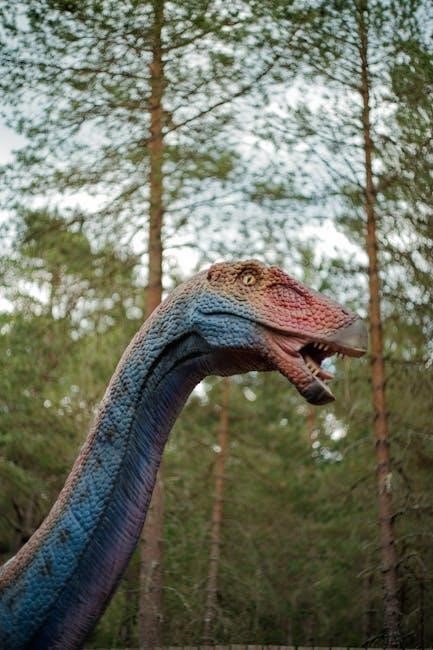dinosaur guide

Dinosaurs were fascinating creatures that dominated Earth during the Mesozoic Era, showcasing incredible diversity. Studying these prehistoric beings reveals insights into evolution, ecosystems, and life’s resilience.
1.1 What Are Dinosaurs?
Dinosaurs were a diverse group of reptiles that dominated Earth during the Mesozoic Era. They existed in various forms, from small, feathered creatures to massive herbivores and fearsome predators. These fascinating beings adapted to different habitats and played a crucial role in shaping ecosystems. Dinosaurs went extinct 66 million years ago, likely due to an asteroid impact, leaving behind a legacy of fossils and scientific intrigue.
1.2 The Significance of Studying Dinosaurs
Studying dinosaurs provides insights into evolution, ancient ecosystems, and biodiversity. By analyzing fossils, scientists gain knowledge about Earth’s history, climate change, and extinction events. Dinosaurs help us understand how species adapt and evolve, offering lessons for modern conservation efforts and environmental science. Their study also sparks curiosity and education, inspiring future generations to explore Earth’s past and its relevance to our present.

Evolution and History of Dinosaurs
Dinosaurs emerged around 230 million years ago, evolving from reptilian ancestors. They dominated Earth during the Mesozoic Era, showcasing remarkable diversity in size, form, and adaptations.
2.1 When and Where Did Dinosaurs First Appear?
Dinosaurs first appeared approximately 230 million years ago during the Middle to Late Triassic period. They evolved from reptilian ancestors in what is now South America and Africa. The earliest dinosaurs were small and lizard-like, but over time, they diversified and spread across the globe, adapting to various environments and ecological niches.
2.2 The Dinosaur Era: Triassic, Jurassic, and Cretaceous Periods
The Triassic period (252–201 million years ago) marked the emergence of dinosaurs. The Jurassic (201–145 million years ago) saw their diversification into herbivores and carnivores. The Cretaceous (145–66 million years ago) was dominated by hadrosaurs and tyrannosaurs, ending with their mass extinction. Each era shaped their evolution and ecological dominance, culminating in a diverse prehistoric landscape;

Types of Dinosaurs
Dinosaurs varied greatly in size, shape, and diet, ranging from small, feathered creatures to massive herbivores and fearsome predators. Their diversity shaped Mesozoic ecosystems.
3.1 Herbivorous Dinosaurs: Stegosaurus, Triceratops, and Diplodocus
Herbivorous dinosaurs, like Stegosaurus, Triceratops, and Diplodocus, played a vital role in ancient ecosystems. Stegosaurus used its plated tail for defense, while Triceratops relied on its distinctive horns and frill. Diplodocus, with its long, slender body, likely browsed high foliage. These plant-eaters adapted unique traits to survive, emphasizing their importance in shaping Mesozoic landscapes through their feeding behaviors and social herding instincts.
3.2 Carnivorous Dinosaurs: Tyrannosaurus Rex, Velociraptor, and Allosaurus
Carnivorous dinosaurs like Tyrannosaurus Rex, Velociraptor, and Allosaurus were apex predators, dominating their ecosystems. T. Rex, with its immense bite force, was a solitary hunter, while Velociraptors, known for their intelligence, hunted in packs. Allosaurus, a Jurassic predator, used its sharp teeth and powerful jaws to take down large prey. These dinosaurs exemplified adaptation and efficiency in their hunting strategies, showcasing the diversity of predatory evolution.
Dinosaur Size and Scale
Dinosaurs ranged from tiny creatures to gigantic beings, with sizes reflecting their roles in ecosystems. Their scale influenced survival strategies, from foraging to defense, shaping their evolution.
4.1 The Largest Dinosaurs: Argentinosaurus and Brachiosaurus
Argentinosaurus, a massive sauropod, is considered the heaviest land animal, weighing over 80 tons. Brachiosaurus, another giant, reached lengths of 26 meters and weighed around 50 tons. These herbivores roamed during the Cretaceous and Jurassic periods, respectively. Their enormous size allowed them to reach high vegetation and deter predators, showcasing evolutionary adaptations for survival in prehistoric ecosystems.
4.2 The Smallest Dinosaurs: Compsognathus and Mussaurus
Compsognathus, a small carnivore, measured about 1 meter long and weighed around 3.5 kg, making it one of the smallest dinosaurs. Mussaurus, a sauropodomorph, was similarly petite, likely herbivorous, and lived during the Triassic. These tiny creatures were agile and likely lived in groups, showcasing the diversity of dinosaur sizes and survival strategies in ancient ecosystems.
4.3 Why Size Mattered for Dinosaurs
Dinosaur size influenced survival strategies, with larger species like Brachiosaurus using height for feeding and defense, while smaller ones like Compsognathus relied on agility and speed. Size affected metabolic rates, resource competition, and reproductive success, shaping ecological roles and evolutionary paths. Larger dinosaurs dominated herbivorous niches, while smaller ones excelled in hunting or scavenging, highlighting size’s critical role in their diverse lifestyles and adaptations.
Dinosaur Diet and Digestion
Dinosaurs had diverse eating habits, with herbivores like Stegosaurus consuming plants, while carnivores like Tyrannosaurus Rex hunted meat. Their digestion systems were adapted to their diets, ensuring survival.
5.1 How Herbivorous Dinosaurs Ate Plants
Herbivorous dinosaurs, like Stegosaurus and Triceratops, used specialized teeth and jaws to eat plants. Stegosaurus had a beaked mouth for cropping low-growing vegetation, while Triceratops likely used its frill for display. Some, like Iguanodon, had thumb spikes for gathering food. Diplodocus, with its long neck, probably browsed treetops, adapting to their environments for survival.
5.2 The Hunting Strategies of Carnivorous Dinosaurs
Carnivorous dinosaurs, such as Tyrannosaurus Rex and Velociraptor, employed diverse hunting strategies. T-Rex relied on ambush tactics, using its powerful legs and strong bite force to overpower prey. Velociraptors hunted in packs, leveraging speed and agility to corner victims. Allosaurus likely used sharp teeth and precision to take down larger herbivores, showcasing adaptability in their predatory behaviors.
Dinosaur Behavior and Intelligence
Dinosaurs exhibited complex behaviors, including social grouping and nesting. Evidence suggests some species displayed problem-solving skills, while others, like Velociraptors, hunted in coordinated packs, showing strategic intelligence.
6.1 Were Dinosaurs Social Animals?
Many dinosaurs, like Velociraptors and some herbivorous species, likely lived in groups. Fossilized trackways and nesting sites suggest social behavior. Modern bird behavior, as dinosaur descendants, supports this theory, indicating they communicated and cooperated for survival and reproduction. This social interaction was crucial for hunting, protection, and raising young, showcasing their adaptability and complexity.
6.2 Evidence of Dinosaur Intelligence
Evidence suggests some dinosaurs exhibited intelligent behaviors. Tool use, like sharpened stones for processing food, indicates problem-solving skills. Advanced brain structures and behaviors, such as nesting strategies, further support this. Modern bird intelligence, as direct dinosaur descendants, aligns with these observations, showing dinosaurs were capable of complex thought and adaptability, aiding their survival in diverse environments during the Mesozoic Era.

Dinosaur Fossils and Paleontology
Dinosaur fossils are crucial for understanding their biology and history. Paleontologists discover and analyze these remains to uncover insights into their behavior, evolution, and extinction, shaping our knowledge of prehistoric life.
7.1 How Fossils Are Discovered and Analyzed
Fossils are discovered through systematic searches in sedimentary rocks. Once found, they are carefully excavated using brushes and tools. In the lab, fossils undergo CT scans and 3D reconstruction to reveal details. Scientists analyze these remains to understand dinosaur anatomy, behavior, and evolution, providing critical insights into Earth’s prehistoric life and ecosystems.
7.2 Famous Fossil Discoveries: T. Rex and Spinosaurus
The Tyrannosaurus Rex fossil “Sue” is one of the most complete T. Rex discoveries, providing extensive insights into its biology. The Spinosaurus fossil found in Egypt revealed its distinctive sail and aquatic adaptations. These discoveries revolutionized our understanding of dinosaur diversity and behavior, offering a glimpse into their prehistoric lives and environments.
The Extinction of Dinosaurs
The dinosaurs’ abrupt extinction marks the end of the Cretaceous period. The asteroid impact theory is widely accepted, but volcanic activity and climate change are also considered contributing factors.
8.1 The Asteroid Impact Theory
The Asteroid Impact Theory suggests a massive asteroid struck Earth, creating the Chicxulub crater. This event caused tsunamis, earthquakes, and global firestorms, leading to a “nuclear winter.” The blockage of sunlight devastated plant life, affecting herbivores and, in turn, carnivores. This theory is widely accepted as the primary cause of the mass extinction, marking the end of the dinosaur era.
8.2 Other Theories: Volcanic Activity and Climate Change
Volcanic activity and climate change are alternative theories explaining dinosaur extinction. Massive eruptions, like those forming the Deccan Traps, released toxic gases, causing environmental stress. Climate change may have altered habitats and disrupted ecosystems. These factors, while not as widely accepted as the asteroid impact, provide additional context for the complex conditions leading to the dinosaurs’ demise.

Dinosaurs in Modern Culture
Dinosaurs captivate modern culture through films, media, and education. Movies like Jurassic Park and scientific research keep them relevant, inspiring curiosity and fascination across generations globally.
9.1 Dinosaurs in Movies and Media: Jurassic Park and Beyond
Dinosaurs have become cultural icons, captivating audiences in films like Jurassic Park, which revolutionized visual effects. Documentaries and series further popularize these prehistoric creatures, blending science with storytelling to educate and entertain. Their enduring appeal in media reflects humanity’s timeless fascination with these majestic beings, making them a staple in modern entertainment and education.
9.2 Dinosaurs in Science and Education
Dinosaurs play a vital role in advancing scientific knowledge and education. They inspire research in paleontology, genetics, and ecology, offering insights into evolution and Earth’s history. Educational programs and museums use dinosaur fossils to engage students, fostering curiosity and interest in STEM fields. Their study bridges science and learning, making them a cornerstone of educational curricula worldwide.
Dinosaur Research and Technology
Modern technology revolutionizes dinosaur research through AI, DNA analysis, and 3D scanning, enabling scientists to uncover new secrets about prehistoric life with unprecedented precision and accuracy.
10.1 Advances in Dinosaur Research: DNA and Genetics
Recent advancements in DNA sequencing and genetic studies have revolutionized dinosaur research, offering insights into their evolutionary relationships and biology. Scientists now analyze well-preserved fossils to extract genetic material, tracing connections between species and modern birds. These breakthroughs illuminate dinosaur physiology, behavior, and diversity, reshaping our understanding of their prehistoric world and their place in the tree of life.
10.2 The Role of AI in Studying Dinosaurs
Artificial Intelligence has transformed dinosaur research by analyzing vast datasets, identifying patterns, and reconstructing prehistoric life. AI algorithms enhance fossil reconstruction, predict behavior, and simulate ecosystems. Machine learning aids in classifying species and understanding evolutionary links. These technologies accelerate discoveries, offering unprecedented insights into dinosaur biology and their connection to modern species, revolutionizing paleontology and our understanding of ancient worlds.

Dinosaur Museums and Exhibits
Dinosaur museums showcase fossils, skeletons, and lifelike reconstructions, offering insights into prehistoric life. Exhibits educate visitors about dinosaur biology, habitats, and extinction, preserving history for future generations.
11.1 The Best Dinosaur Museums in the World
Renowned dinosaur museums include the American Museum of Natural History in New York, the Natural History Museum in London, and the Royal Tyrrell Museum in Canada. These institutions house exceptional fossil collections, interactive exhibits, and reconstructed skeletons, offering visitors a glimpse into the prehistoric world. They are must-visit destinations for dinosaur enthusiasts and researchers alike.
11.2 How Dinosaurs Are Preserved and Displayed
Dinosaur fossils are carefully preserved through meticulous excavation and laboratory preparation. Museums display these fossils in reconstructed skeletons or dioramas, often alongside life-sized models. Interactive exhibits and digital displays enhance understanding. The goal is to educate visitors about dinosaur biology and behavior, while inspiring awe for these prehistoric creatures.
The Future of Dinosaur Studies
The future of dinosaur research lies in advanced technologies like AI and DNA analysis, offering new insights into their biology and evolution.
12.1 Emerging Trends in Paleontology
Emerging trends in paleontology include the integration of AI and machine learning for fossil analysis, 3D scanning for detailed reconstructions, and advanced genetic research. These technologies enable scientists to uncover new insights into dinosaur biology and behavior. Additionally, virtual databases and collaborative platforms are revolutionizing how researchers share and study fossils, making the field more accessible and innovative than ever before.
12.2 What We Still Don’t Know About Dinosaurs
Despite extensive research, many dinosaur mysteries remain unsolved. Their exact colors, detailed social behaviors, and some extinction factors are still debated. Additionally, the full complexity of their genetic makeup and how certain species adapted to varied climates remain unclear. These gaps highlight the ongoing challenges and intriguing puzzles in dinosaur research, encouraging further exploration and discovery.



Leave a Reply
You must be logged in to post a comment.